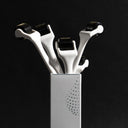Hair loss is a common concern for many men, and it can have a significant impact on self-esteem and overall confidence. While it's often thought of as an inevitable part of aging, the question remains: can a man's hair actually grow back? In this article, we'll explore the possibilities of hair regrowth and the various factors that can influence it.
Table of content
Can a man's hair grow back?
Yes, in many cases, a man's hair can grow back, particularly if the hair loss is caught and treated early. However, the ability for hair to regrow depends on several factors, including the underlying cause of hair loss, the extent of hair loss, and the individual's age and overall health.
Understanding the Causes of Hair Loss
To determine the likelihood of hair regrowth, it's essential to identify the underlying cause of hair loss. The most common type of hair loss in men is androgenetic alopecia, also known as male pattern baldness. This condition is primarily caused by a combination of genetics and hormones, specifically dihydrotestosterone (DHT).
Other causes of hair loss in men can include:
- Telogen effluvium (temporary hair shedding due to stress, illness, or medication)
- Alopecia areata (an autoimmune condition causing patchy hair loss)
- Nutritional deficiencies
- Certain medical conditions or treatments (e.g., chemotherapy)
Treatments for Hair Regrowth
Depending on the cause of hair loss, several treatments can potentially promote hair regrowth in men:
Minoxidil
Minoxidil is a topical medication approved by the FDA for treating male pattern baldness. It is applied directly to the scalp and has been shown to stimulate hair growth in many men. While it doesn't cure hair loss, consistent use can help slow the progression and promote regrowth.
Finasteride
Finasteride is an oral medication that works by blocking the conversion of testosterone to DHT, the hormone responsible for male pattern baldness. By reducing DHT levels, finasteride can help prevent further hair loss and promote regrowth in some men.
Low-Level Laser Therapy (LLLT)
LLLT involves exposing the scalp to low-intensity laser light, which is believed to stimulate hair follicles and promote hair growth. While the results are mixed, some studies have shown promising outcomes.
Platelet-Rich Plasma (PRP) Therapy
PRP therapy involves extracting a patient's blood, separating the platelet-rich plasma, and injecting it back into the scalp. The growth factors in the plasma are thought to stimulate hair follicles and promote new hair growth.
Hair Transplantation
For men with advanced hair loss or those seeking a more permanent solution, hair transplantation may be an option. This surgical procedure involves removing healthy hair follicles from the back and sides of the scalp and transplanting them to areas of thinning or baldness.
Factors Affecting Hair Regrowth
While treatments can promote hair regrowth, several factors can influence the success and extent of regrowth, including:
- Age: Hair regrowth tends to be more successful in younger men, as older individuals may have fewer viable hair follicles.
- Stage of Hair Loss: Early intervention is crucial, as hair regrowth becomes more challenging with advanced hair loss.
- Genetics: Some individuals may have a stronger genetic predisposition to hair loss, making regrowth more difficult.
- Overall Health: Underlying medical conditions, nutritional deficiencies, or hormonal imbalances can impact hair regrowth.
Realistic Expectations and Consistency
It's important to have realistic expectations when it comes to hair regrowth. While treatments can be effective, they may not restore a full head of hair to its former density and thickness, especially in cases of advanced hair loss. Additionally, consistent and long-term use of treatments is often necessary to maintain results, as hair loss can resume if treatment is discontinued.
Consulting with a dermatologist or trichologist can help determine the most appropriate treatment plan and provide personalized guidance on achieving the best possible outcomes for hair regrowth.
Tired of seeing more hair in the shower drain than on your head?
Bio-Pilixin® Activation Serum is a clinically tested, drug-free approach to combat hair loss and promote new growth. Our unique formula, with plant growth factors derived from stem cell technology, nourishes hair follicles and extends the hair growth phase.
Here's what Bio-Pilixin can do for you:
- Help reduce hair loss by 93% (clinically tested!)
- Experience thicker, denser hair after 150 days
- Safe and gentle for everyday use
- Botanical, vegan ingredients you can feel good about
97% of users see results, and 85% prefer us over other products.
Read more:
- Dermatologist's Guide To The Best Derma Roller For Hair Growth
- 11 Best Shampoos For Thinning Hair Due To Menopause & Itchy Scalp
- 19 Best & Proven Shampoos For Hair Thinning In 2024
As your leading source for hair health information over the past 4 years, we never compromise on accuracy. When it comes to your health, you deserve information you can truly rely on - and earning your trust is our top priority.
Here's how Scandinavian Biolabs ensures every piece of content meets the highest standards of accuracy and integrity:
- Credentialed Experts: Our reviewers are actively practicing doctors and medical researchers
- Stringent Reviews: Content undergoes rigorous editing by subject specialists and review by a practicing doctor.
- Evidence-Based: We rely on well-established research from trusted scientific sources like peer-reviewed journals and health authorities.
- Full Transparency: Our editorial standards, writer credentials, reviewer credentials, correction process, and funding are all publicly documented.
- Independent Voice: While we do promote products, we operate in a vacuum to business operations. Our main goal is just an unwavering commitment to providing medically-sound guidance.
You can count on Scandinavian Biolabs to consistently deliver the trustworthy health information you deserve. Read our Editorial Standards.






